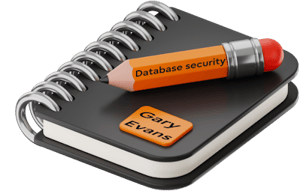These are not just buzzwords; they're critical pieces in the cybersecurity puzzle, bridging the gap between the Identify and Protect pillars of the NIST framework.

Why governance matters beyond the boardroom
So, what's the big deal with governance? In simple terms, it's about setting the rules - and as DBAs, you're the enforcers. Governance is the framework that dictates how data should be handled, who has access to it, and how to respond to security incidents. It's like the rulebook of a sport: knowing the rules helps you play the game effectively and keeps everything in check.
Key governance activities for DBAs
Policy development
 Your deep understanding of the organization's data architecture is a vital asset in the Policy Development process. It's not merely technical expertise; it's the foundation for crafting effective and applicable policies. When handling sensitive data, such as personal identifiable information (PII), your ability to determine the appropriate handling methods is critical for ensuring both safety and regulatory compliance, for instance, with standards like GDPR.
Your deep understanding of the organization's data architecture is a vital asset in the Policy Development process. It's not merely technical expertise; it's the foundation for crafting effective and applicable policies. When handling sensitive data, such as personal identifiable information (PII), your ability to determine the appropriate handling methods is critical for ensuring both safety and regulatory compliance, for instance, with standards like GDPR.
Managing data access is also a significant part of your cybersecurity policy role. You are tasked with setting up access controls that correspond to user roles and data sensitivity. Furthermore, your responsibilities include implementing robust authentication measures, like multi-factor authentication, to enhance data security against unauthorized access. Your expertise should be leveraged in the establishment and testing of these policies, not solely their implementation.
In the area of risk management, your contribution is again significant. By conducting regular audits and risk assessments, you identify potential vulnerabilities that might be exploited in cyberattacks. Your insights are key to shaping policies that effectively mitigate these risks.
Collaboration is another critical aspect of your role. Working alongside departments like IT security, legal, and HR is essential to ensure that the policies you develop are thorough and address all necessary aspects.
Remember, the world of cybersecurity is constantly evolving, and so must your policies. As a DBA, you play a crucial role in keeping these policies current, continuously adapting them to meet new threats and shifting business requirements.
In summary, your role as a DBA in policy development is multifaceted. You're not just a technical expert; you're a strategic contributor to the cybersecurity posture of your organization. Your involvement in policy development ensures that these strategies are technically sound, practical, comprehensive, and aligned with both organizational goals and standards like the NIST framework. This emphasizes your value in the broader context of organizational security, extending well beyond traditional database management.
User access control
 In a previous article in this series (Securing your PostgreSQL kingdom: A guide to authorization and cybersecurity framework alignment), we touched on the importance of user access control and looked to the CIS PostgreSQL Benchmark for guidance in best practices. Let's briefly revisit this topic to clarify its role in your day-to-day responsibilities, especially how it fits within the broader cybersecurity governance framework.
In a previous article in this series (Securing your PostgreSQL kingdom: A guide to authorization and cybersecurity framework alignment), we touched on the importance of user access control and looked to the CIS PostgreSQL Benchmark for guidance in best practices. Let's briefly revisit this topic to clarify its role in your day-to-day responsibilities, especially how it fits within the broader cybersecurity governance framework.
As a DBA, user access control is a critical component of your cybersecurity strategy. It involves determining who has the right to access different types of data within your organization. Your role here is crucial: you need to ensure that data remains accessible to those who need it, while also upholding robust security measures to protect this data.
A key part of this responsibility is understanding user roles and the sensitivity of the data you manage. When you categorize data and set access rights based on these factors, you effectively manage the flow of information. This approach is not only essential for enhancing data security but also for ensuring that your organization complies with various standards and regulations.
In the wider scope of cybersecurity governance, and particularly in alignment with the NIST's Identify and Protect pillars, your work in user access control is vital. It's where the governance policies you've helped develop become practical actions in the management of your database systems. This aspect of your role is fundamental in bridging the gap between policy and practice, ensuring that the data in your care remains secure and properly governed.
Compliance monitoring
 As a Database Administrator, your role in compliance monitoring is essential to uphold the governance framework you've contributed to. It's crucial for you to ensure that the databases comply with a range of data security and privacy regulations, such as GDPR, HIPAA, and other regional laws. This responsibility goes beyond technical database management; it requires a thorough understanding of legal standards related to data storage, processing, and sharing, and how they impact your work.
As a Database Administrator, your role in compliance monitoring is essential to uphold the governance framework you've contributed to. It's crucial for you to ensure that the databases comply with a range of data security and privacy regulations, such as GDPR, HIPAA, and other regional laws. This responsibility goes beyond technical database management; it requires a thorough understanding of legal standards related to data storage, processing, and sharing, and how they impact your work.
Your tasks include implementing and vigilantly overseeing compliance measures within the database systems. You're responsible for setting up database structures and access controls that meet regulatory standards, including the encryption of personal data when necessary. Conducting regular audits to review and document adherence to these regulations is a key part of your role. You should also monitor data access and sharing within the organization to ensure it aligns with both policy and legal requirements. Collaborating with legal, compliance, and IT security teams will be vital in integrating your technical expertise with the broader compliance strategy of your organization.
Staying abreast of changes in data regulation is imperative. As laws and best practices in data management evolve, you must proactively adapt your knowledge and practices to maintain compliance. This ongoing learning process is essential to protect your organization from legal risks and maintain its reputation for data integrity and security. Remember, your expertise in compliance monitoring is an important piece of the organization's governance structure, requiring a balance of technical skill and a comprehensive grasp of legal and regulatory demands.
Data security: Where the rubber meets the road
Now, let's shift gears to data security. This is where you roll up your sleeves and get to work. Data security is all about protecting the data - the crown jewels of any organization. It's here where your expertise and actions truly impact the security posture of your organization.
As a DBA, there are numerous facets of data security that require your attention. However, let's focus on three key areas that should be at the top of your priority list:
Data encryption
 As we discussed in our earlier blog (Unlocking the Secrets of Encryption in Database Security), think of data encryption as putting your data into a safe. It's a critical security measure whether the data is sitting idle (at rest) or moving across the network (in transit). Encryption acts as a failsafe, ensuring that even if data is intercepted or accessed without authorization, it remains indecipherable and secure. Your responsibility as a DBA involves not only implementing but also maintaining robust encryption standards. This means staying up to date with the latest developments in encryption technology and updating your practices accordingly to ensure maximum security.
As we discussed in our earlier blog (Unlocking the Secrets of Encryption in Database Security), think of data encryption as putting your data into a safe. It's a critical security measure whether the data is sitting idle (at rest) or moving across the network (in transit). Encryption acts as a failsafe, ensuring that even if data is intercepted or accessed without authorization, it remains indecipherable and secure. Your responsibility as a DBA involves not only implementing but also maintaining robust encryption standards. This means staying up to date with the latest developments in encryption technology and updating your practices accordingly to ensure maximum security.
In this context, it's worth noting the emphasis that Fujitsu places on its Transparent Data Encryption feature. It is increasingly being recognized as a vital component in the database security toolkit. It provides an efficient way to encrypt data at the database level, enhancing security without significantly impacting performance. As a DBA, understanding and effectively utilizing features like Transparent Data Encryption is becoming ever more important in today's data-centric world, where safeguarding information is paramount.
Data masking
As a Database Administrator (DBA), implementing data masking in live systems is a crucial strategy you should consider, particularly when managing access to sensitive information like credit card numbers. Data masking is invaluable for scenarios where different users need varying levels of data access. It allows you to obscure specific parts of the data — for example, showing only the last four digits of a credit card number — while keeping the rest confidential. This technique is particularly essential in environments where lower privileged users require access to certain data elements for operational purposes but don't need, and shouldn't have, full visibility of sensitive data.
 The beauty of data masking lies in its ability to maintain both data usability and security. By implementing this in your database systems, you ensure that necessary business functions can be carried out by various user groups without compromising the confidentiality of critical data. This is not just about protecting data; it's about smartly balancing accessibility with security, which is a key aspect of your role.
The beauty of data masking lies in its ability to maintain both data usability and security. By implementing this in your database systems, you ensure that necessary business functions can be carried out by various user groups without compromising the confidentiality of critical data. This is not just about protecting data; it's about smartly balancing accessibility with security, which is a key aspect of your role.
Moreover, data masking helps in mitigating risks associated with data breaches and unauthorized access. In today's environment, where data security is paramount, this feature can be a game-changer. It not only protects sensitive information but also helps in maintaining compliance with data protection regulations. By effectively employing data masking, you play a pivotal role in safeguarding your organization's data integrity, all while ensuring that day-to-day operations are seamless and efficient. This strategic approach to data management underlines the importance of your role as a DBA in the broader context of organizational security and compliance.
Incorporating data masking into your Fujitsu Enterprise Postgres databases, is an astute move as a DBA, especially in the current landscape where data security is non-negotiable. Fujitsu's Data Masking feature stands out for its policy-based approach, catering to a range of needs from straightforward obfuscation to more intricate regular expression-based masking for unstructured data types such as JSON or XML. This flexibility allows you to tailor data visibility according to user privileges and operational requirements, ensuring a fine-tuned balance between data confidentiality and usability. Embracing such advanced data masking capabilities not only fortifies sensitive data but also aligns with compliance directives, reinforcing your pivotal role in upholding your organization's data integrity and contributing to the broader spectrum of organizational security and regulatory adherence.
Backup and Recovery
 The role of a database administrator in backup and recovery is evolving. With the advent of cloud computing and advanced database technologies, you have more tools and methodologies at your disposal than ever before. Leveraging these tools effectively requires staying updated with the latest advancements in database technology and backup solutions.
The role of a database administrator in backup and recovery is evolving. With the advent of cloud computing and advanced database technologies, you have more tools and methodologies at your disposal than ever before. Leveraging these tools effectively requires staying updated with the latest advancements in database technology and backup solutions.
In conclusion, backup and recovery are not just about preserving data; they are about safeguarding the operational integrity and resilience of the business. As a DBA, your expertise and strategic approach to backup and recovery are vital in protecting the organization's data assets against a multitude of threats and ensuring compliance with various regulatory requirements. This role underscores the criticality of your position in maintaining the health and security of the organization's data ecosystem.
From Identify to Protect: First, you identify what you need to protect (thanks to your governance policies). Then, you actively protect it (hello, data security measures!).
This isn't a one-and-done deal. The data security measures you put in place might lead to tweaking your governance policies. It's an ongoing cycle of improvement.
Conclusion
 In the broad spectrum of cybersecurity, governance and data security form the cornerstone of your responsibilities as a DBA. These elements bring both excitement and significant challenges to your role. In today's rapidly evolving and data-centric world, the importance of your role cannot be overstated. It's time to gear up and rise to the occasion - your organization's security and success greatly depend on your expertise and vigilance!
In the broad spectrum of cybersecurity, governance and data security form the cornerstone of your responsibilities as a DBA. These elements bring both excitement and significant challenges to your role. In today's rapidly evolving and data-centric world, the importance of your role cannot be overstated. It's time to gear up and rise to the occasion - your organization's security and success greatly depend on your expertise and vigilance!
Keep an eye out for our upcoming blog, where we'll delve into more activities under the Protect pillar and begin exploring those that align with the Detect pillar of the NIST Cybersecurity Framework.
Want to know more? Then subscribe to be notified of new posts.


 Hello, database dynamos!
Hello, database dynamos! 





